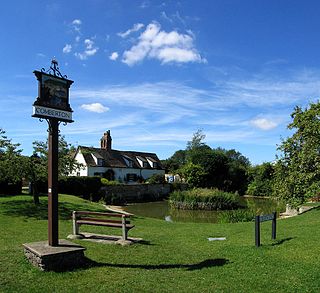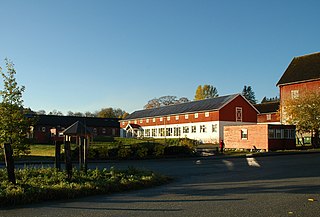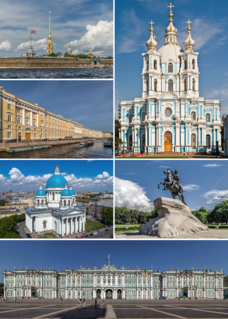
Svalbard is a Norwegian archipelago in the Arctic Ocean. Situated north of mainland Europe, it is about midway between continental Norway and the North Pole. The islands of the group range from 74° to 81° north latitude, and from 10° to 35° east longitude. The largest island is Spitsbergen, followed by Nordaustlandet and Edgeøya. Administratively, the archipelago is not part of any Norwegian county, but forms an unincorporated area administered by a governor appointed by the Norwegian government. Since 2002, Svalbard's main settlement, Longyearbyen, has had an elected local government, somewhat similar to mainland municipalities. Other settlements include the Russian mining community of Barentsburg, the research station of Ny-Ålesund, and the mining outpost of Sveagruva. Ny-Ålesund is the northernmost settlement in the world with a permanent civilian population. Other settlements are farther north, but are populated only by rotating groups of researchers.

The Mariinsky Theatre is a historic theatre of opera and ballet in Saint Petersburg, Russia. Opened in 1860, it became the preeminent music theatre of late 19th-century Russia, where many of the stage masterpieces of Tchaikovsky, Mussorgsky, and Rimsky-Korsakov received their premieres. Through most of the Soviet era, it was known as the Kirov Theatre. Today, the Mariinsky Theatre is home to the Mariinsky Ballet, Mariinsky Opera and Mariinsky Orchestra. Since Yuri Temirkanov's retirement in 1988, the conductor Valery Gergiev has served as the theatre's general director.

Comberton is a village and civil parish in South Cambridgeshire, England, just east of the Prime Meridian.

Boris Vyacheslavovich Gryzlov, is a Russian politician. He was Interior Minister from 2001 to 2003 and Speaker of the State Duma from 2003 to 2011. He is one of the leaders of the largest Russian political party, United Russia. Boris Gryzlov is a close ally of President Vladimir Putin.
Karl König was an Austrian paediatrician who founded the Camphill Movement, an international movement of therapeutic intentional communities for those with special needs or disabilities.

Botton is a small village within the North York Moors National Park in North Yorkshire, England which is mainly a Camphill Community for people with learning disabilities.

ITMO University is a large state university in Saint Petersburg and is one of Russia's National Research Universities. ITMO University is one of 15 Russian universities that were selected to participate in Russian Academic Excellence Project 5-100 by the government of the Russian Federation to improve their international competitiveness among the world's leading research and educational centers.

Valentina Ivanovna Matviyenko (Russian: Валенти́на Ива́новна Матвие́нко, IPA: [vəlʲɪnˈtʲinə ɪˈvanəvnə mətvʲɪˈjɛnkə], Ukrainian: Валентина Іванівна Матвієнко,, is a Russian politician serving as the Senator from Saint Petersburg and Chairwoman of the Federation Council since 2011. Previously she was Governor of Saint Petersburg from 2003 to 2011.
Belarusians are a major ethnic group in Russia. In the census of 2002, 807,970 Russian citizens confirmed their Belarusian ethnicity. Major Belarusian groups live in the regions of Moscow, St. Petersburg, Kaliningrad, Karelia. Most Belarusians in Russia are migrants from modern Belarus or their descendants, while a minor part of Belarusians in Russia are indigenous.

Rotvoll is a neighbourhood in the city of Trondheim in Trøndelag county, Norway. It is located in the borough of Østbyen. It is located next to the Trondheim fjord between Leangen to the west and Ranheim to the east.

Odyssey House Texas, located in Houston, Texas is a private not-for-profit organization established in 1989 to provide treatment and education to youth and families whose lives have been devastated by drugs, alcohol, and abuse. At that time, local families who had lost their children to drugs, alcohol and death identified the need for an effective and affordable program.
Put Domoi is a Russian street newspaper sold by the homeless in St. Petersburg, published twice monthly. The sellers receive half of the price. It was started in 1994 as Na Dne by Nochlezhka, an organization for the homeless. It was renamed to its current name in 2003. It was closely modeled after The Big Issue and is a member of the International Network of Street Papers (INSP). The paper has been critical of human rights violations in Russia which has made it some enemies. The INSP has been important for financial support and political legitimacy.
The 'M. N. Adamov Fund for the Blind is a non-profit organization dedicated to helping talented blind people in Russia.
Scientology has been subjected to considerable persecution in Russia.

The Russian cruiser Svetlana was a protected cruiser of the Imperial Russian Navy. She was the flagship of the Commander-in-Chief of the Imperial Russian Navy and was used as a royal yacht in peacetime. She was sunk in combat during Battle of Tsushima in the Russo-Japanese War.
Thomas Weihs was a doctor, farmer and special needs educator, one of the founders and leading co-workers of the Camphill Movement and a pioneer of Anthroposophical curative education.

Carlo Pietzner, born in Vienna, Austria, 26 January 1915 and died in Copake, New York, 17 April 1986, was a co-founder of Camphill, artist, anthroposophist, and a Special Needs and adult educator.




















